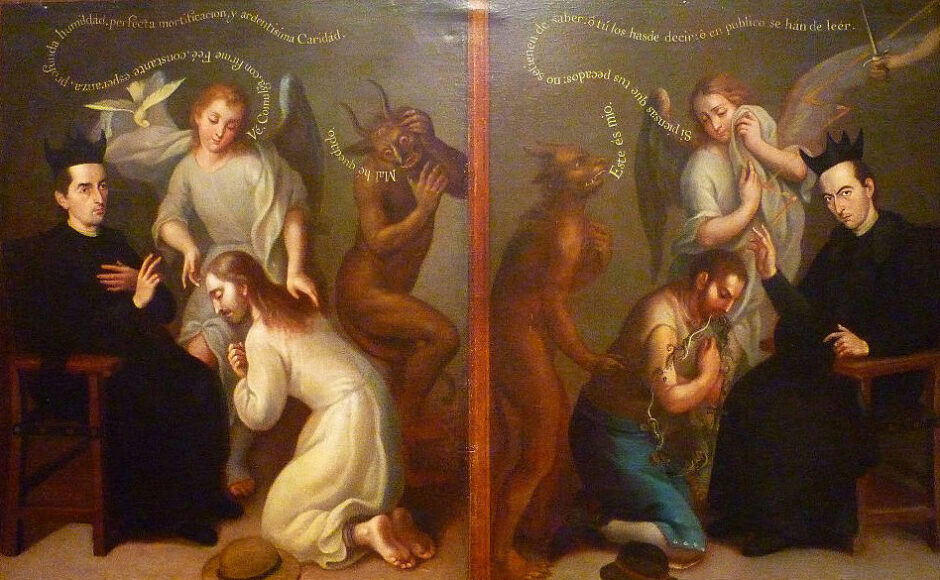Today’s prayer has roots in the Padua manuscript the so-called Gregorian Sacramentary and also the manuscript at Bergamo. It was not in any edition of the pre-Conciliar Missale Romanum.
COLLECT
Maiestatem tuam, Domine, suppliciter imploramus,
ut, quanto magis dies salutiferae festivitatis accedit,
tanto devotius ad eius celebrandum
proficiamus paschale mysterium.
Accedo is “to go or come to or near, to approach”. Proficio means “to go forward, advance, gain ground, make progress” and thus “to be useful, serviceable, advantageous, etc.”
I believe the eius refers back to dies. Devotius, an adverb of devoveo, is rarely “devout” in the modern sense. It concerns promises and consecrations and religious duties. Again, our phrase maiestas tua seems to be nearly a form of address. At the same time it is an effective characteristic of God.
LITERAL TRANSLATION
Humbly we implore Your Majesty, O Lord,
that by howsomuch more the day of the salvation bringing feast draws near
by that degree we may more dedicatedly make progress
toward its paschal mystery which it is to be celebrated.
There is today a strong suggestion of motion and movement. It reminds me of the prayers of Advent, where we are given strong images of rushing, nearly hurtling toward our desired goal along paths which are to be made “straight” according to the Baptist’s warning. As a matter of fact, this prayer and the Post Communion of the 4th Sunday of Advent are very similar.
There is a phrase in Latin, and it applies well to life: in finem citius… things go faster as they draw closer to the end. In our prayer we see the same proportional relationship between the proximity of the Paschal Mystery and our “approach” to it, if you will pardon the double entendre. With every day, nay hour, that passes, we ought to be more and more focused on our Lenten observance so that the celebration of Easter and “its” Paschale Mystery will be that much more fruitful. By “its” Paschale Mystery, I get the sense the we are talking also about the Triduum leading to the Vigil. Lent ends at the beginning of the Triduum.
Consider this also from a liturgical point of view.
We are half way into Lent now. At the beginning of Lent the Church began to die to herself liturgically speaking. Elements of the liturgy, in which we can “actively participate” are taken away from us. The Church says that there is to be no instrumental music in Lent, with the exception of sustaining congregational singing. What the Church means is a little organ, not a band, to do so. Flowers and ornaments in church are curtailed. We no longer have the Gloria and Alleluia.
When 1st Passion Sunday would arrive in the older, Roman calendar, the Iudica me was stripped out of the prayers at the foot of the altar. There was no Gloria Patri at ends of antiphons. Statues and images were draped and hidden from view. Again, the Church is dying to herself and our active participation in the sensory elements of Mass is being reduced.
At the Triduum, we are given a brief flash of glory at the Mass of the Last Supper and then the Blessed Sacrament is hidden away. The altar is stripped entirely. Bells are no longer sounded. Holy Water is removed. On Good Friday we are deprived even of Mass, though we can have Communion and on Holy Saturday we cannot even have Communion. Remember that reception of Holy Communion is the most perfect form of “active participation”. So, it is as if on that day the Church is dead, awaiting the resurrection. At the beginning of the Vigil we are even deprived of light with which to see.
Some thoughts on that quanto…tanto construction.

































Well, there’s lovely consonance between the “-to” endings of both quanto and tanto, and also between the two adverbs attached to both of them i.e. “quanto magis… tanto devotius”. In fact, in the case of the second this is even “strengthened”, so to speak, by “devotius” being followed by “eius” (albeit with “ad” in between). That probably makes it very satisfying both to sing and to hear sung, and also of course to recite.
BTW, that is a lovely imagery of the Holy Week Triduum, Father. Thank you very much for that.
Thanks for mentioning the point about the sound of the prayer when sung! It is a pleasure to sing them, too.
The speeding up of time in the liturgy creates an expectation in children as well, if the parents are paying attention and helping the children to really listen.
And, does not time seem to be speeding up as well in Rome?
“The Church says that there is to be no instrumental music in Lent with the exception of sustaining congregational singing.”
In all humility, I am wondering if this rule is perhaps ‘dispensed’ in some dioceses or if perhaps a pastor can relax the ‘no instruments’ rule. The piano + folk instrument choirs carry on as usual throughout Lent in our local NO parishes, with the omission of the Gloria, etc.
Our local EF Mass does follow this rule in Lent.
Call me Curious…
I suspect a lot of people in “music ministry” have no idea about the Lent/instrumental music thing.
Father Z: “I suspect a lot of people in “music ministry” have no idea about the Lent/instrumental music thing.”
But what about their pastors? (With whom the parish musical buck stops?)
Henry: Yes, they have a responsibility to know. The new generation will probably, as a group, be more attentive.
These commentaries are wonderful, both theologically and linguistically!
Question for Father Z (and you might have answered it before): Are you planning on collecting them into a volume and publish (or self-publish on Lulu and sell through Amazon)? I bet many of the readers of this blog would buy a copy.